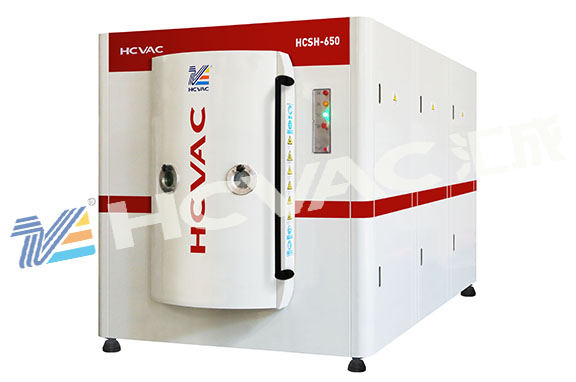definition:
The process of bombarding the solid surface with particles (ions or neutral atoms, molecules) of a certain energy, so that the atoms or molecules near the surface of the solid obtain enough energy and finally escape from the solid surface. under vacuum

The process of bombarding the surface of a solid with particles (ions or neutral atoms, molecules) with a certain energy, so that the atoms or molecules near the surface of the solid obtain sufficient energy and finally escape from the surface of the solid.
Vacuum coating machine sputtering can only be carried out in a certain vacuum state.
Principle
The bombarding particles used in vacuum coater sputtering are usually positively charged inert gas ions, and argon ions are the most used. After ionization of argon, the argon ions gain kinetic energy under the acceleration of the electric field to bombard the target. When the energy of argon ions is lower than 5 electron volts, it only acts on the outermost surface layer of the target, and mainly desorbs the impurities originally adsorbed on the surface of the target. When the argon ion energy reaches the binding energy of the target atoms (about the sublimation heat of the target material), the atoms on the surface of the target migrate and cause surface damage. When the energy of the bombarding particles exceeds four times the sublimation heat of the target material, the atoms are pushed out of the lattice position to escape from the vapor phase and sputtering occurs. For most metals, the sputtering threshold energy is about 10-25 electron volts.
Sputtering output of vacuum coater
That is, the average number of atoms sputtered by a unit incident ion bombarding the target is related to the energy of the incident ion. For sputtering near the threshold energy, the yield is only 10-5 to 10-4 atoms/ion. With the increase of the incident ion energy, the sputtering yield of the vacuum coater increases exponentially. When the ion energy is 103-104 electron volts, the sputtering yield reaches a stable maximum value; when the energy exceeds 104 electron volts, the sputtering yield decreases due to the obvious ion implantation phenomenon. The sputtering yield is also related to the target material, atomic binding energy, lattice structure and crystal orientation. Generally speaking, the sputtering yield of single metal vacuum coating machine is higher than that of its alloy; among insulating materials, amorphous sputtering yield is the highest, followed by single crystal, and composite crystal is the lowest.
Vacuum coating machine sputtering process
The sputtering process of vacuum coating machine is mainly used in two aspects: sputter etching and thin film deposition of vacuum coater. During sputtering etching, the etched material is placed at the target position and etched by the bombardment of argon ions. The etching rate is related to the sputtering yield of the target material, the ion flux density and the vacuum degree of the sputtering chamber. During the sputtering etching of the vacuum coater, the sputtered target atoms should be removed from the sputtering chamber of the vacuum coater as much as possible. A common method is to introduce a reactive gas to react with the sputtered target atoms to generate volatile gas, which is discharged from the sputtering chamber through a vacuum system. When depositing thin films, the sputtering source is placed on the target, and sputtering occurs after being bombarded by argon ions. If the target material is elemental, the elemental film of the target material will be formed on the substrate; if the reactive gas is intentionally introduced into the sputtering chamber, it will chemically react with the sputtered target atoms to deposit on the substrate, The compound thin film of the target material can be formed. Usually, compound or alloy thin films are prepared by direct sputtering with compound or alloy targets. In sputtering, the sputtered atoms are sputtered after exchanging energy with high-energy ions with thousands of electron volts. The adhesion of the film to the substrate is better than that of evaporation. If the substrate is properly biased during sputtering, the cleaning of the substrate can be taken into account, which is also beneficial for the step coverage of the generated film. In addition, the sputtering method of a
vacuum coating machine can prepare a material film with a high melting point and a low vapor pressure that cannot be prepared by an evaporation process, which is convenient for preparing thin films of compounds or alloys. There are two main methods of sputtering: ion beam sputtering and plasma sputtering. In the ion beam sputtering device, a directional ion beam provided by an ion gun with a certain energy bombards the target to generate sputtering. The ion gun doubles as substrate cleaning and target sputtering. To avoid charge build-up on insulating solid surfaces, sputtering with a charged neutral beam can be used. Neutral beams result from the neutralization of energetic positive ions by electrons before leaving the ion gun. Ion beam sputtering is widely used in surface analysis instruments to clean or delaminate samples. Rapid film deposition for large-area substrates is difficult due to the limited beam spot size.
Plasma
vacuum coating machine sputtering is also called glow discharge sputtering. The positive ions required for sputtering originate from the plasma in the glow discharge. The surface of the target must have a high negative potential, and the positive ions are accelerated by this electric field to obtain kinetic energy to bombard the target to produce sputtering, and at the same time, the bombardment of the substrate by electrons inevitably occurs.



